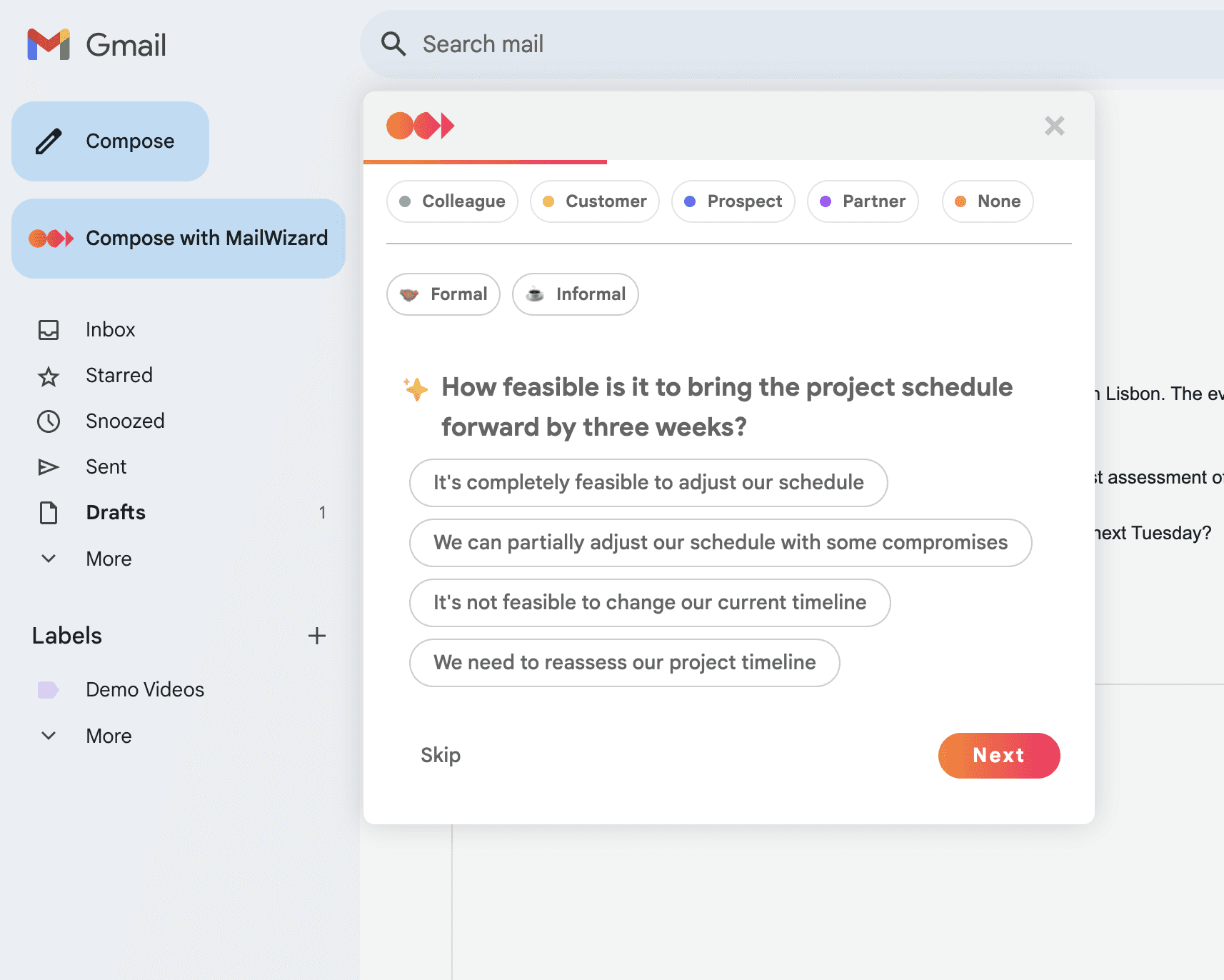




This is the fourth in a series of 5 articles chronicling my journey as a solo developer building MailWizard, an AI-powered email assistant. If you missed the beginning, check out Part 1: The Birth of MailWizard to get the full picture.
While the switch to Claude was overwhelmingly positive, it wasn't without its hurdles. As with any major technological shift, there were a few bumps along the road that required some creative problem-solving. Let me take you through some of the challenges I faced and how I tackled them.
The Streaming Conundrum
While Claude brought significant improvements to MailWizard, it wasn't all smooth sailing. One major challenge I encountered was working with Claude's function calling capabilities in a streaming context.
Here's the deal: Claude's current models only emit one complete key-value pair at a time when using function calls. This caused noticeable delays between streaming events, which wasn't ideal for MailWizard's real-time responsiveness. After all, nobody wants to wait for their AI assistant like they're waiting for a slow internet connection, right?
To tackle this, I turned to Anthropic's documentation on increasing output consistency. The solution? Precisely defining the desired output format using JSON. It's like giving Claude a very specific recipe to follow. Here's a simplified version of what I came up with:
You're an Email Analysis AI. Parse the following email and generate questions to gather more context. Output your response in this specific JSON format: <formatting> Provide your output as a valid, compact JSON object (without any extra whitespace or line breaks) with a "questions" key containing an array of question objects. Each question object should have the following structure: {"questions":[{"text":"Question text here","multiple_answers":boolean,"answers":[{"text":"Answer option text","has_additional_information":boolean},...]}]} Ensure that your response adheres to this JSON structure and includes all necessary fields for each question and answer option. </formatting> Email to analyze: "Subject: Urgent: Project Falcon Update Required Dear team, We need to provide an update on Project Falcon for the upcoming board meeting. Please send me your progress reports by EOD tomorrow. If there are any roadblocks, highlight them clearly. Best, Sarah"
This approach was a game-changer. It not only guaranteed a valid JSON output every time but also maintained the speed I needed for MailWizard's snappy performance. It was like teaching Claude to speak MailWizard's language fluently.
The Upside of Claude
Despite these challenges, what stood out with Claude was how much easier it was to get started and troubleshoot issues compared to GPT-4. When Claude wasn't following an instruction directly, often simply rephrasing the prompt or providing more context would solve the problem. It felt less like wrestling with an AI and more like having a conversation with a particularly intelligent (if sometimes literal-minded) colleague.
The impact on MailWizard's functionality was significant:
The questions generated for users became more focused and relevant.
Users could provide more pertinent information, leading to better email outputs.
The emails generated by Claude had a more natural tone and structure.
One user summed it up nicely: "It's like having a super-smart assistant who actually gets what I'm trying to say!" Another noted, "I used to spend ages tweaking AI-generated emails, but with MailWizard, it's usually spot-on the first time."
The Power of Community
I may be a solo developer, but I'm far from alone in this journey. Anthropic's responsive support and active developer community were invaluable during this period. Their Discord channel became my go-to place for troubleshooting and idea-sharing.
It was a reminder that even when you're coding late into the night (fueled by determination and perhaps too much coffee), you're part of a larger community of developers all working to push the boundaries of AI.
Lessons Learned
As I ironed out these kinks, MailWizard began to take on a new level of sophistication. Each challenge overcome wasn't just a problem solved; it was a stepping stone to a more powerful, more efficient application.
The key takeaway? Flexibility is crucial when working with AI. What works today might need adjustment tomorrow as models evolve and improve. Being ready to adapt and think creatively is part of the exciting journey of AI development.
What's Next?
Ready for the grand finale? In the final article of this series, I share my reflections on this wild ride and paint a picture of MailWizard's exciting future. We'll dive into the hard-won lessons, the big dreams, and my vision for where AI-powered email assistance is heading. Don't miss out on this thrilling conclusion to our journey!
Ready to experience hassle-free emailing? Don't wait for the final installment - try MailWizard today! Our AI-powered email assistant, refined through real-world challenges and powered by Claude, offers an unparalleled email experience. Say goodbye to clunky interfaces and hello to smooth, intelligent email composition. With MailWizard, you're not just using an email tool; you're stepping into the future of communication. Try MailWizard now and see how we've turned AI challenges into user triumphs!
This is the fourth in a series of 5 articles chronicling my journey as a solo developer building MailWizard, an AI-powered email assistant. If you missed the beginning, check out Part 1: The Birth of MailWizard to get the full picture.
While the switch to Claude was overwhelmingly positive, it wasn't without its hurdles. As with any major technological shift, there were a few bumps along the road that required some creative problem-solving. Let me take you through some of the challenges I faced and how I tackled them.
The Streaming Conundrum
While Claude brought significant improvements to MailWizard, it wasn't all smooth sailing. One major challenge I encountered was working with Claude's function calling capabilities in a streaming context.
Here's the deal: Claude's current models only emit one complete key-value pair at a time when using function calls. This caused noticeable delays between streaming events, which wasn't ideal for MailWizard's real-time responsiveness. After all, nobody wants to wait for their AI assistant like they're waiting for a slow internet connection, right?
To tackle this, I turned to Anthropic's documentation on increasing output consistency. The solution? Precisely defining the desired output format using JSON. It's like giving Claude a very specific recipe to follow. Here's a simplified version of what I came up with:
You're an Email Analysis AI. Parse the following email and generate questions to gather more context. Output your response in this specific JSON format: <formatting> Provide your output as a valid, compact JSON object (without any extra whitespace or line breaks) with a "questions" key containing an array of question objects. Each question object should have the following structure: {"questions":[{"text":"Question text here","multiple_answers":boolean,"answers":[{"text":"Answer option text","has_additional_information":boolean},...]}]} Ensure that your response adheres to this JSON structure and includes all necessary fields for each question and answer option. </formatting> Email to analyze: "Subject: Urgent: Project Falcon Update Required Dear team, We need to provide an update on Project Falcon for the upcoming board meeting. Please send me your progress reports by EOD tomorrow. If there are any roadblocks, highlight them clearly. Best, Sarah"
This approach was a game-changer. It not only guaranteed a valid JSON output every time but also maintained the speed I needed for MailWizard's snappy performance. It was like teaching Claude to speak MailWizard's language fluently.
The Upside of Claude
Despite these challenges, what stood out with Claude was how much easier it was to get started and troubleshoot issues compared to GPT-4. When Claude wasn't following an instruction directly, often simply rephrasing the prompt or providing more context would solve the problem. It felt less like wrestling with an AI and more like having a conversation with a particularly intelligent (if sometimes literal-minded) colleague.
The impact on MailWizard's functionality was significant:
The questions generated for users became more focused and relevant.
Users could provide more pertinent information, leading to better email outputs.
The emails generated by Claude had a more natural tone and structure.
One user summed it up nicely: "It's like having a super-smart assistant who actually gets what I'm trying to say!" Another noted, "I used to spend ages tweaking AI-generated emails, but with MailWizard, it's usually spot-on the first time."
The Power of Community
I may be a solo developer, but I'm far from alone in this journey. Anthropic's responsive support and active developer community were invaluable during this period. Their Discord channel became my go-to place for troubleshooting and idea-sharing.
It was a reminder that even when you're coding late into the night (fueled by determination and perhaps too much coffee), you're part of a larger community of developers all working to push the boundaries of AI.
Lessons Learned
As I ironed out these kinks, MailWizard began to take on a new level of sophistication. Each challenge overcome wasn't just a problem solved; it was a stepping stone to a more powerful, more efficient application.
The key takeaway? Flexibility is crucial when working with AI. What works today might need adjustment tomorrow as models evolve and improve. Being ready to adapt and think creatively is part of the exciting journey of AI development.
What's Next?
Ready for the grand finale? In the final article of this series, I share my reflections on this wild ride and paint a picture of MailWizard's exciting future. We'll dive into the hard-won lessons, the big dreams, and my vision for where AI-powered email assistance is heading. Don't miss out on this thrilling conclusion to our journey!
Ready to experience hassle-free emailing? Don't wait for the final installment - try MailWizard today! Our AI-powered email assistant, refined through real-world challenges and powered by Claude, offers an unparalleled email experience. Say goodbye to clunky interfaces and hello to smooth, intelligent email composition. With MailWizard, you're not just using an email tool; you're stepping into the future of communication. Try MailWizard now and see how we've turned AI challenges into user triumphs!
This is the fourth in a series of 5 articles chronicling my journey as a solo developer building MailWizard, an AI-powered email assistant. If you missed the beginning, check out Part 1: The Birth of MailWizard to get the full picture.
While the switch to Claude was overwhelmingly positive, it wasn't without its hurdles. As with any major technological shift, there were a few bumps along the road that required some creative problem-solving. Let me take you through some of the challenges I faced and how I tackled them.
The Streaming Conundrum
While Claude brought significant improvements to MailWizard, it wasn't all smooth sailing. One major challenge I encountered was working with Claude's function calling capabilities in a streaming context.
Here's the deal: Claude's current models only emit one complete key-value pair at a time when using function calls. This caused noticeable delays between streaming events, which wasn't ideal for MailWizard's real-time responsiveness. After all, nobody wants to wait for their AI assistant like they're waiting for a slow internet connection, right?
To tackle this, I turned to Anthropic's documentation on increasing output consistency. The solution? Precisely defining the desired output format using JSON. It's like giving Claude a very specific recipe to follow. Here's a simplified version of what I came up with:
You're an Email Analysis AI. Parse the following email and generate questions to gather more context. Output your response in this specific JSON format: <formatting> Provide your output as a valid, compact JSON object (without any extra whitespace or line breaks) with a "questions" key containing an array of question objects. Each question object should have the following structure: {"questions":[{"text":"Question text here","multiple_answers":boolean,"answers":[{"text":"Answer option text","has_additional_information":boolean},...]}]} Ensure that your response adheres to this JSON structure and includes all necessary fields for each question and answer option. </formatting> Email to analyze: "Subject: Urgent: Project Falcon Update Required Dear team, We need to provide an update on Project Falcon for the upcoming board meeting. Please send me your progress reports by EOD tomorrow. If there are any roadblocks, highlight them clearly. Best, Sarah"
This approach was a game-changer. It not only guaranteed a valid JSON output every time but also maintained the speed I needed for MailWizard's snappy performance. It was like teaching Claude to speak MailWizard's language fluently.
The Upside of Claude
Despite these challenges, what stood out with Claude was how much easier it was to get started and troubleshoot issues compared to GPT-4. When Claude wasn't following an instruction directly, often simply rephrasing the prompt or providing more context would solve the problem. It felt less like wrestling with an AI and more like having a conversation with a particularly intelligent (if sometimes literal-minded) colleague.
The impact on MailWizard's functionality was significant:
The questions generated for users became more focused and relevant.
Users could provide more pertinent information, leading to better email outputs.
The emails generated by Claude had a more natural tone and structure.
One user summed it up nicely: "It's like having a super-smart assistant who actually gets what I'm trying to say!" Another noted, "I used to spend ages tweaking AI-generated emails, but with MailWizard, it's usually spot-on the first time."
The Power of Community
I may be a solo developer, but I'm far from alone in this journey. Anthropic's responsive support and active developer community were invaluable during this period. Their Discord channel became my go-to place for troubleshooting and idea-sharing.
It was a reminder that even when you're coding late into the night (fueled by determination and perhaps too much coffee), you're part of a larger community of developers all working to push the boundaries of AI.
Lessons Learned
As I ironed out these kinks, MailWizard began to take on a new level of sophistication. Each challenge overcome wasn't just a problem solved; it was a stepping stone to a more powerful, more efficient application.
The key takeaway? Flexibility is crucial when working with AI. What works today might need adjustment tomorrow as models evolve and improve. Being ready to adapt and think creatively is part of the exciting journey of AI development.
What's Next?
Ready for the grand finale? In the final article of this series, I share my reflections on this wild ride and paint a picture of MailWizard's exciting future. We'll dive into the hard-won lessons, the big dreams, and my vision for where AI-powered email assistance is heading. Don't miss out on this thrilling conclusion to our journey!
Ready to experience hassle-free emailing? Don't wait for the final installment - try MailWizard today! Our AI-powered email assistant, refined through real-world challenges and powered by Claude, offers an unparalleled email experience. Say goodbye to clunky interfaces and hello to smooth, intelligent email composition. With MailWizard, you're not just using an email tool; you're stepping into the future of communication. Try MailWizard now and see how we've turned AI challenges into user triumphs!
This is the fourth in a series of 5 articles chronicling my journey as a solo developer building MailWizard, an AI-powered email assistant. If you missed the beginning, check out Part 1: The Birth of MailWizard to get the full picture.
While the switch to Claude was overwhelmingly positive, it wasn't without its hurdles. As with any major technological shift, there were a few bumps along the road that required some creative problem-solving. Let me take you through some of the challenges I faced and how I tackled them.
The Streaming Conundrum
While Claude brought significant improvements to MailWizard, it wasn't all smooth sailing. One major challenge I encountered was working with Claude's function calling capabilities in a streaming context.
Here's the deal: Claude's current models only emit one complete key-value pair at a time when using function calls. This caused noticeable delays between streaming events, which wasn't ideal for MailWizard's real-time responsiveness. After all, nobody wants to wait for their AI assistant like they're waiting for a slow internet connection, right?
To tackle this, I turned to Anthropic's documentation on increasing output consistency. The solution? Precisely defining the desired output format using JSON. It's like giving Claude a very specific recipe to follow. Here's a simplified version of what I came up with:
You're an Email Analysis AI. Parse the following email and generate questions to gather more context. Output your response in this specific JSON format: <formatting> Provide your output as a valid, compact JSON object (without any extra whitespace or line breaks) with a "questions" key containing an array of question objects. Each question object should have the following structure: {"questions":[{"text":"Question text here","multiple_answers":boolean,"answers":[{"text":"Answer option text","has_additional_information":boolean},...]}]} Ensure that your response adheres to this JSON structure and includes all necessary fields for each question and answer option. </formatting> Email to analyze: "Subject: Urgent: Project Falcon Update Required Dear team, We need to provide an update on Project Falcon for the upcoming board meeting. Please send me your progress reports by EOD tomorrow. If there are any roadblocks, highlight them clearly. Best, Sarah"
This approach was a game-changer. It not only guaranteed a valid JSON output every time but also maintained the speed I needed for MailWizard's snappy performance. It was like teaching Claude to speak MailWizard's language fluently.
The Upside of Claude
Despite these challenges, what stood out with Claude was how much easier it was to get started and troubleshoot issues compared to GPT-4. When Claude wasn't following an instruction directly, often simply rephrasing the prompt or providing more context would solve the problem. It felt less like wrestling with an AI and more like having a conversation with a particularly intelligent (if sometimes literal-minded) colleague.
The impact on MailWizard's functionality was significant:
The questions generated for users became more focused and relevant.
Users could provide more pertinent information, leading to better email outputs.
The emails generated by Claude had a more natural tone and structure.
One user summed it up nicely: "It's like having a super-smart assistant who actually gets what I'm trying to say!" Another noted, "I used to spend ages tweaking AI-generated emails, but with MailWizard, it's usually spot-on the first time."
The Power of Community
I may be a solo developer, but I'm far from alone in this journey. Anthropic's responsive support and active developer community were invaluable during this period. Their Discord channel became my go-to place for troubleshooting and idea-sharing.
It was a reminder that even when you're coding late into the night (fueled by determination and perhaps too much coffee), you're part of a larger community of developers all working to push the boundaries of AI.
Lessons Learned
As I ironed out these kinks, MailWizard began to take on a new level of sophistication. Each challenge overcome wasn't just a problem solved; it was a stepping stone to a more powerful, more efficient application.
The key takeaway? Flexibility is crucial when working with AI. What works today might need adjustment tomorrow as models evolve and improve. Being ready to adapt and think creatively is part of the exciting journey of AI development.
What's Next?
Ready for the grand finale? In the final article of this series, I share my reflections on this wild ride and paint a picture of MailWizard's exciting future. We'll dive into the hard-won lessons, the big dreams, and my vision for where AI-powered email assistance is heading. Don't miss out on this thrilling conclusion to our journey!
Ready to experience hassle-free emailing? Don't wait for the final installment - try MailWizard today! Our AI-powered email assistant, refined through real-world challenges and powered by Claude, offers an unparalleled email experience. Say goodbye to clunky interfaces and hello to smooth, intelligent email composition. With MailWizard, you're not just using an email tool; you're stepping into the future of communication. Try MailWizard now and see how we've turned AI challenges into user triumphs!
Get MailWizard
Revolutionize Your Daily Emails
Choose the perfect plan for your email needs - from our forever-free plan to professional and enterprise solutions. Experience AI-powered email assistance that grows with you.

Get MailWizard
Revolutionize Your Daily Emails
Choose the perfect plan for your email needs - from our forever-free plan to professional and enterprise solutions. Experience AI-powered email assistance that grows with you.

Get MailWizard
Revolutionize Your Daily Emails
Choose the perfect plan for your email needs - from our forever-free plan to professional and enterprise solutions. Experience AI-powered email assistance that grows with you.


Copyright ©2024 MailWizard

Copyright ©2024 MailWizard

Copyright ©2024 MailWizard
